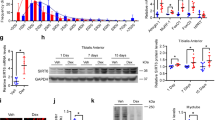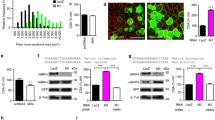Abstract
Administration of glucocorticoids results in hypertension, cardiac hypertrophy, and general myopathy. The present study analyzed the acute effect of dexamethasone (0.5 mg/100 g for 3 days) or dexamethasone plus insulin-like growth factor-1 (0.35 mg/100 g for 3 days) on differential gene expression in the gastrocnemius muscle and the left ventricular myocardium of rats. Dexamethasone induced atrophy of gastrocnemius muscle. Cathepsin L, and not ubiquitin, was the earliest mediator of skeletal muscle proteolysis induced by dexamethasone. Insulin-like growth factor-1 reversed gastrocnemius muscle mass, and deleted a part of downregulated genes by dexamethasone. On the other hand, dexamethasone administration did not result in cardiac hypertrophy or hypertension. Only prostaglandin D synthase gene was upregulated by dexamethasone in myocardium, and genes related to extracellular matrix and proteinase inhibitor were downregulated. Molecular alteration for hypertrophy might have initiated. Dexamethasone-induced proteolysis and reversal with insulin-like growth factor-1 occurred rapidly in skeletal muscle; but was relatively delayed in the myocardium.
Similar content being viewed by others
References
Hasselgren PO. Stress and muscle wasting. J Anim Sci 80(E Suppl 2):E50-E55.
May R, Kelly RA, Mitch WE. Metabolic acidosis stimulates protein degradation in rat muscle by a glucocorticoiddependent mechanism. J Clin Invest 1986;77:614-621.
Savary I, Debras E, Dardevet D, et al. Effects of glucocorticoid excess on skeletal muscle and heart protein synthesis in adult and old rats. Brit J Nutr 1998;79:297-304.
Skelton R, Gill AB, Parsons JM. Cardiac effects of short course dexamethasone in preterm infants. Arch Dis Child Fetal Neonatal Ed 1998;78:F133-F137.
Whitehurst RM, Zhang M, Bhattacharjee A, Li M. Dexamethasone-induced hypertrophy in rat neonatal cardiac myocytes involves an elevated L-type Ca2+ current. J Mol Cell Cardiol 1999;31:1551-1558.
Muangmingsuk S, Ingram P, Gupta MP, Arcilla RA, Gupta M. Dexamethasone induced cardiac hypertrophy in newborn rats is accompanied by changes in myosin heavy chain phenotype and gene transcription. Mol Cell Biochem 2000;209:165-174.
Chrysis D, Underwood LE, Regulation of components of the ubiquitin system by insulin-like growth factor I and growth hormone in skeletal muscle of rats made catabolic with dexamethasone. Endocrinology 1999;140:5635-5641.
Konagaya M, Bernard PA, Max SR. Blockade of glucocorticoid receptor binding and inhibition of dexamethasoneinduced muscle atrophy in the rat by RU38486, a potent glucocorticoid antagonist. Endocrinology 1986;119:375-380.
Kurowski TT, Czerwinski SM. Glucocorticoid modulation of cardiac mass and protein. Med Sci Sports Exerc 1990;22:312-315.
Savary I, Debras E, Dardevet D, et al. Effect of glucocorticoid excess on skeletal muscle and heart protein synthesis in adult and old rats. Br J Nutr 1998;79:297-304.
Ikeda K, Nara Y, Yamori Y. Indirect systolic and mean blood pressure determination by a new tail cuff method in spontaneously hypertensive rats. Laboratory Animals 1991;25:26-29.
Lowry OH, Rosenbrough NJ, Farr AL, Randall RJ. Protein measurement with the Folin phenol reagent. J Biol Chem 1951;193:265-275.
OkudaT, Sumiya T, Mizutani K, et al. Analyses of differential gene expression in genetic hypertensive rats by microarray. Hypertens Res 2002;25:249-255.
Okuda T, Sumiya T, Iwai N, Miyata T. Difference of gene expression profiles in spontaneous hypertensive rats and Wister-Kyoto rats from two sources. Biochem Biophys Res Commun 2002;296:537-543.
Chomczynski P, Sacchi N. Single-step method of RNA isolation by acid guanidinium thiocyanate-phenol-chloroform extraction. Anal Biochem 1987;162:156-159.
Kennan A, Aherne A, Palfi A, et al. Identification of an IMPDH1 mutation in autosomal dominant retinitis pigmentosa (RP10) revealed following comparative microarray analysis of transcripts derived from retinas of wild-type and Rho(-/-) mice. Hum Mol Genet 2002;11:547-557.
Brooks HL, Ageloff S, Kwon TH, et al. cDNA array identification of genes regulated in rat renal medulla in response to vasopressin infusion.AmJ Physiol Renal Physiol 2003;284:F218-F228.
Hwang DM, Dempsey AA, Wang RX, et al. A genome-based resource for molecular cardiovascular medicine: Toward a compendium of cardiovascular genes. Circulation 1997;96:4146-4203.
McGrath ME. The lysosomal cystein protease. Annu Rev Biophy Biomol Struct 1999;28:181-204.
Huang J, Forsberg E. Role of Calpain in skeletal-muscle protein degradation. Proc Natl Acad Sci USA 1998;95:12100-12105.
Wing SS, Goldberg AL. Glucocorticoids activate the ATP-ubiquitin-dependent proteolytic system in skeletal muscle during fasting. Am J Physiol 1993;264:E668-E676.
Auclair D, Garrel DR, Zerouala AC, Ferland LH. Activation of the ubiquitin pathway in rat skeletal muscle by catabolic doses of glucocorticoids. AmJ Physiol 1997;C1007-1016.
Deval C, Mordier S, Obled C, et al. Identification of cathepsin L as a differentially expressed message associated with skeletal muscle wasting. Biochem J 2001;360:143-150.
Yang H, Grahn M, Schalch DS, Ney DM. Anabolic effects of IGF-I coinfused with total parenteral nutrition in dexamethasone-treated rats. Am J Physiol 1994;266:E690-E698.
Fang CH, Li BG, Sun X, Hasselgren PO. Insulin-like growth factor I reduces ubiquitin and ubiquitin-conjugating enzyme gene expression but does not inhibit muscle proteolysis in septic rats. Endocrinology 2000;141:2743-2751.
Rommel C, Bodine SC, Clarke BA, et al. Mediation of IGF-1-induced skeletal myotube hypertrophy by PI(3)K/Akt/mTOR and PI(3)K/Akt/GSK3 pathways. Nat Cell Biol 2001;3:1009-1013.
Bodine SC, Stitt TN, Gonzalez M, et al. Akt/mTOR pathway is a crucial regulator of skeletal muscle hypertrophy and can prevent muscle atrophy in vivo. Nat Cell Biol 2001;3:1014-1019.
Suzuki H, Handa M, Kondo K, Saruta T. Role of renninangiotensin system in glucocorticoid hypertension in rats. Am J Physiol 1982;243:E48-E51.
Whitworth JA. Mechanisms of glucocorticoid-induced hypertension. Kidney Int 1987;31:1213-1224.
Sato A, Suzuki H, Nakazato Y, Shibata H, Inagami T, Saruta T. Increased expression of vascular angiotensin II type 1A receptor gene in glucocorticoid-induced hypertension. J Hypertens 1994;12:511-516.
Djavidani B, Sander M, Kreutz R, et al. Chronic dexamethasone treatment suppresses hypertension development in the transgenic rat TGR(mREN2)27. J Hypertens 1995;13:637-645.
Kim CY, Imai Y, Itoi K, et al. Analysis of circadian variation of blood pressure and heart rate in dexamethasone-induced hypertensive rats. Clin Exp Hypertens 1996;18:65-76.
Hunter JJ, Chien KR. Signaling pathways for cardiac hypertrophy and failure. N Engl J Med 1999;341:1276-1283.
Molkentin JD, Dorn II GW 2nd. Cytoplasmic signaling pathways that regulate cardiac hypertrophy. Annu Rev Physiol 2001;63:391-426.
Author information
Authors and Affiliations
Rights and permissions
About this article
Cite this article
Komamura, K., Shirotani-Ikejima, H., Tatsumi, R. et al. Differential Gene Expression in the Rat Skeletal and Heart Muscle in Glucocorticoid-Induced Myopathy: Analysis by Microarray. Cardiovasc Drugs Ther 17, 303–310 (2003). https://doi.org/10.1023/A:1027352703783
Issue Date:
DOI: https://doi.org/10.1023/A:1027352703783




